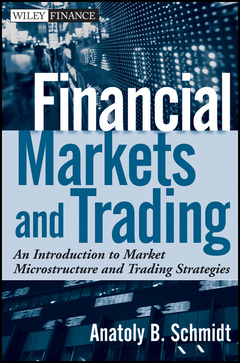Financial Markets and Trading An Introduction to Market Microstructure and Trading Strategies Wiley Finance Series
Auteur : Schmidt Anatoly B.

Over the last decade, the financial landscape has undergone a significant transformation, shaped by the forces of technology, globalization, and market innovations to name a few. In order to operate effectively in today's markets, you need more than just the motivation to succeed, you need a firm understanding of how modern financial markets work and what professional trading is really about. Dr. Anatoly Schmidt, who has worked in the financial industry since 1997, and teaches in the Financial Engineering program of Stevens Institute of Technology, puts these topics in perspective with his new book.
Divided into three comprehensive parts, this reliable resource offers a balance between the theoretical aspects of market microstructure and trading strategies that may be more relevant for practitioners. Along the way, it skillfully provides an informative overview of modern financial markets as well as an engaging assessment of the methods used in deriving and back-testing trading strategies.
- Details the modern financial markets for equities, foreign exchange, and fixed income
- Addresses the basics of market dynamics, including statistical distributions and volatility of returns
- Offers a summary of approaches used in technical analysis and statistical arbitrage as well as a more detailed description of trading performance criteria and back-testing strategies
- Includes two appendices that support the main material in the book
If you're unprepared to enter today's markets you will underperform. But with Financial Markets and Trading as your guide, you'll quickly discover what it takes to make it in this competitive field.
Acknowledgments xiii
PART ONE
Market Microstructure 1
CHAPTER 1
Financial Markets: Traders, Orders, and Systems 3
Traders 3
Orders 5
The Bid/Ask Spread 7
Liquidity 9
Market Structures 9
Continuous Order-Driven Markets 10
Oral Auctions 11
Call Auctions 12
Quote-Driven Markets and Hybrid Markets 13
CHAPTER 2
Modern Financial Markets 15
The U.S. Equity Markets 15
The NYSE 15
NASDAQ 16
Alternative Trading Systems 17
European Equity Markets 18
Spot FX Market 19
The U.S. Fixed Income Markets 21
High-Frequency Trading 22
CHAPTER 3
Inventory Models 26
Risk-Neutral Models 26
The Garman’s Model 26
Amihud-Mendelson Model 29
Models with Risk Aversion 29
What Is Risk Aversion? 29
The Stoll’s Model 31
CHAPTER 4
Market Microstructure: Information-Based Models 35
Kyle’s Model 35
One-Period Model 35
Multi-Period and Multi-Insider Models 38
Glosten-Milgrom Model 39
Further Developments 41
CHAPTER 5
Models of the Limit-Order Markets 44
The CMSW Model 44
The Parlour Model 46
The Foucault Model 47
Equilibrium at Zero Volatility 48
Volatility Effect 49
New Developments 50
CHAPTER 6
Empirical Market Microstructure 53
Roll’s Model 53
The Glosten-Harris Model 55
Structural Models 56
Recent Empirical Findings 58
Equity Markets 58
Global FX Spot Market 60
PART TWO
Market Dynamics 63
CHAPTER 7
Statistical Distributions and Dynamics of Returns 65
Prices and Returns 65
The Efficient Market Hypothesis 66
Random Walk and Predictability of Returns 68
Recent Empirical Findings 69
Fractals in Finance 72
CHAPTER 8
Volatility 75
Basic Notions 75
Conditional Heteroskedasticity 77
Realized Volatility 79
Market Risk Measurement 81
CHAPTER 9
Agent-Based Modeling of Financial Markets 86
Adaptive Equilibrium Models 87
Non-Equilibrium Price Models 89
The Observable-Variables Model 91
Modeling Efficiency of Technical Trading 94
Modeling the Birth of a Two-Sided Market 95
PART THREE
Trading Strategies 101
CHAPTER 10
Technical Trading Strategies 103
Trend Strategies 105
Filter Rules 105
Moving-Average Rules 106
Channel Breakouts 107
Momentum and Oscillator Strategies 109
Complex Geometric Patterns 113
CHAPTER 11
Arbitrage Trading Strategies 117
Hedging Strategies 118
Pair Trading 120
Cointegration and Causality 121
Pair Selection 123
Arbitrage Risks 125
CHAPTER 12
Back-Testing of Trading Strategies 129
Performance Measures 131
Resampling Techniques 133
Bootstrap 133
Markov Chain Monte Carlo 135
Random Entry Protocol 136
Comparing Trading Strategies 137
Bootstrap Reality Check 138
New Developments 139
CHAPTER 13
Execution Strategies 142
Benchmark-Driven Schedules 143
Cost-Driven Schedules 145
Risk-Neutral Framework 145
Risk-Averse Framework 147
The Taker’s Dilemma 151
The Random Walk Model 153
Simulations of the Execution Costs 154
APPENDIX A
Probability Distributions 156
Basic Notions 156
Frequently Used Distributions 159
The Uniform Distribution 159
The Binomial Distribution 159
The Poisson Distribution 160
The Normal Distribution 160
The Lognormal Distribution 161
The Cauchy Distribution 162
The Gamma Distribution 162
Stable Distributions and Scale Invariance 162
APPENDIX B
Elements of Time Series Analysis 165
The Autoregressive Model 165
The Moving Average Model 167
The ARMA Model 168
Trends and Seasonality 170
Multivariate Time Series 172
Notes 174
References 180
About the Author 190
Index 191
DR. ANATOLY B. SCHMIDT holds a master of science and PhD in physics from University of Latvia. He has been working as a quantitative analyst in the financial industry since 1997. Dr. Schmidt has published several papers on agent-based modeling of financial markets, market microstructure, and algorithmic trading as well as a book entitled Quantitative Finance for Physicists: An Introduction. He also teaches in the Financial Engineering Program of Stevens Institute of Technology.
Date de parution : 08-2011
Ouvrage de 208 p.
16.3x23.6 cm
Thème de Financial Markets and Trading :
Mots-clés :
Anatoly Schmidt, financial markets, trading, market microstructure, trading strategies, financial market organization, market price formation, agent-based modeling, arbitrage trading strategies, pairs trading, mean-reversion strategies, optimal order slicing, taker?s dilemma, time series analysis, linear regression, autoregressive, moving average models, trends, co-integration, conditional heteroskedasticity, resampling techniques, bootstrap, MCMC, execution strategies, implementation shortfall



